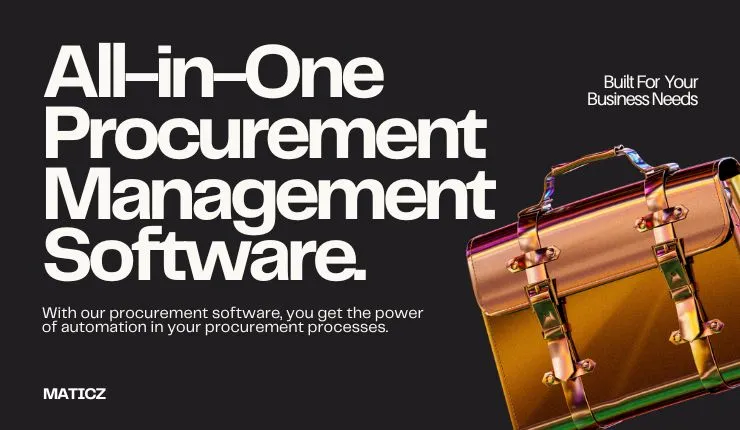Share Posts

Best Procurement Software
46
2890
103
What is Procurement Management Software?
Procurement management software is an innovative business tool designed to help companies automate their entire procurement process starting from sourcing to payment. It allows them to purchase products, approve orders, and automate vendor payments all in one place. It creates transparency into how efficiently a company is using its cash to purchase goods and services. In general, procurement is one of the important business functions that involves acquiring goods and services through sourcing, negotiating terms, ordering purchases, tracking timely delivery of products or services, and maintaining their records.
This software offers a centralized platform that gives complete access to control every procurement activity, making it easier for involved teams to collaborate, track progress, and make data-driven decisions. It facilitates the purchase of products and services from anywhere worldwide and avoids the burden of extensive manual work. It is equipped with the tools to analyze current spending on products and budgets. This helps build insight into the company's spending which ensures its financial stability and encourages growth.
Why Do Companies Need Procurement Software?
Due to the major shift towards cloud-based solutions and digitization to streamline procurement processes, the demand for procurement management software is on the rise. No matter what business you are in, procurement software is important for a sustainable and scalable business.
Procurement software is being rapidly adopted by companies involved in shipping, freight, and logistics, especially for cargo and shipment inspections. Its rising adoption is also seen in IT departments with broader organizational workflows.
As per recent studies, the procurement software market size is valued at USD 8.17 billion in 2024 and is likely to hit USD 13.27 billion in 2029 with a CAGR of 10.20%. Right from analyzing and managing spending to managing contracts and making invoice payments.
As businesses grow and diversify so does the complexity of procurement processes. There are many reasons to point out why companies need this type of software. Procurement software allows companies to reduce costs and improve their bottom line for better negotiation, vendor management, and cost analysis. It helps them seamlessly collaborate across geographically dispersed teams anytime, anywhere. Here are some of the reasons why companies need procurement software.
- Transparency into spending and contract compliance
- Strategic sourcing to get the best products at reasonable prices
- Streamlined procurement intake and approval process
- Automate repetitive tasks and alleviate workloads of internal teams to focus on meaningful work
- Offers a centralized platform for easy analysis of supplier lifecycle data
- Compare purchasing options and handle purchase orders
- Support smoother billing processes
Our Procurement Software Services and Solutions
Explore the comprehensive range of procurement software services and solutions designed to streamline purchasing processes and optimize supply chain management.
Strategic Sourcing
Leveraging advanced analytics and artificial intelligence, Strategic sourcing software gathers diverse data such as spending patterns, supplier metrics, market trends, and more for efficient supplier vetting and strategic financial data analysis. It also offers tools required to identify potential suppliers, compare their quotes, and select the best one.
Supplier Management
Supplier management offers a central repository to manage supplier information, contracts, and communication. It helps businesses optimize their interaction with suppliers through automated onboarding, performance tracking, and streamlined communication.
Contract Management
Contract management software helps negotiate terms and conditions, follow regulations, monitor compliance, track obligation dates, and more to ensure the smooth execution of contracting processes and transactions. It sets automated notifications to flag expired contracts and upcoming renewals.
Inventory Management
Inventory management software provides end-to-end visibility for real-time inventory tracking. It accurately tracks current stock levels and ensures that the right amount of goods is available when needed to avoid costs of excess or shortage.
Purchase Management
Purchase management involves handling the purchase of the goods and services that the company requires from suppliers and vendors. It helps obtain procured items at the lowest possible cost to maximize profits while maintaining their quality.
Catalog Management
Catalog management involves creating customizable catalogs of products and services from pre-approved vendors. It provides an automated approval workflow for updated catalog items and compares products across multiple catalogs using parameters like price, features, and delivery date.
Performance Management
Procurement Performance Management (PPM) involves measuring the efficiency and spending of procurement teams within an organization. Based on the estimation, it identifies key areas and improves procedures to help companies improve the value of procurement and meet their business goals.
Procure-to-Pay
Procure-to-pay management solutions integrate purchasing and accounts payable systems to strengthen compliance in contracts and control among vendors and buyers. It allows companies to procure from preferred suppliers at negotiated prices without any manual paperwork and spreadsheets.
Source-to-Pay
Using innovative technologies like big data and digital networks, Source-to-Pay software handles the process starting from finding, negotiating with, and contracting the supplier of goods to making payments in the end. It aggregates purchases across business units to improve performance, drive business value, and fuel collaboration.
Invoice Automation
Invoice automation software extracts invoice data from the business system and automates the process of creating invoices. It not only saves time and money but also improves the accuracy and reduces the risk of fraud.
Features Of Procurement Management System
Modern PMS solutions come with a range of features designed to optimize procurement operations, enhance transparency, and improve cost management. Here are the key features that make a robust Procurement Management System.
Intuitive Interface
The procurement management system offers a clean, organized dashboard with easy navigation, enabling users to perform tasks without extensive training. Its customizable views and drag-and-drop functionality further enhance user experience by allowing users to tailor the interface to their specific needs and preferences.
Curation Options
Users can categorize vendors based on criteria such as product quality, pricing, reliability, and compliance. Automated curation ensures that only the most suitable and high-performing suppliers are included in the procurement process.
Integration with ERP
Procurement management software seamlessly integrates with existing ERP systems to facilitate real-time data exchange and synchronization. This integration ensures that procurement activities align with broader business processes, such as finance, supply chain management, inventory management, and production planning.
Approval Workflows
Users can set up multi-level approval hierarchies based on purchase amounts, departments, or specific criteria. Automated notifications and reminders simplify the approval process, reduce delays, and enhance accountability.
Spend Analytics
Spend analytics tools offer detailed reports and dashboards that provide comprehensive insights into procurement expenditures. Users can track key performance indicators (KPIs) such as cost savings, procurement cycle times, and compliance rates.
Purchase Order
The purchase order feature automates the creation, issuance, and tracking of purchase orders. Users can generate purchase orders based on requisitions, approved requests, or existing contracts.
Invoices and Requisitions
Users can create and submit purchase requisitions, which are then routed for approval. Automated matching and validation reduce errors and discrepancies, ensuring timely and accurate payments to suppliers.
Vendor Portal
Vendors can access the portal to update their profiles, submit quotes, and view purchase orders and payment status. The portal can also facilitate vendor performance management by enabling suppliers to respond to performance evaluations and feedback.
Benefits of Procurement Software
By automating and optimizing procurement activities, this software delivers a host of benefits that enhance efficiency, reduce costs, and improve overall business performance. Here’s an in-depth look at the key benefits of implementing procurement software.
Operational Efficiency
Procurement software provides operational efficiency such as standardized processes, improved inventory governance, and optimization of the supply chain. This leads to reduced errors, enhanced compliance, and a streamlined procurement lifecycle from requisition to payment.
Cost Savings
By providing detailed insights into spending patterns, procurement software enables organizations to identify cost-saving opportunities, negotiate better terms with suppliers, and avoid unnecessary expenditures.
Transparency
Procurement software tracks every transaction, approval, and communication, ensuring that all stakeholders have access to accurate and up-to-date information. This transparency fosters accountability, reduces the risk of fraud, and builds trust within the organization and with external partners.
Improved Scalability
Procurement software supports scalability by accommodating increased transaction volumes and expanding supplier networks without compromising efficiency. It allows organizations to adapt to changing business requirements and market conditions, ensuring that procurement operations remain agile and responsive.
Reduced Manual Processing
The process of manual procurement is time-consuming and susceptible to errors. Procurement software carries out repetitive tasks, reducing the requirement for manual involvement, decreasing errors, and allowing procurement professionals to allocate more time to strategic activities.
Enhanced Collaboration
Procurement software facilitates better collaboration between internal teams and external suppliers. It provides centralized communication platforms where stakeholders can share information, discuss requirements, and resolve issues in real-time.
How We Develop Procurement Management Software?
Developing robust and efficient Procurement Management Software requires a blend of deep domain expertise, cutting-edge technology, and a user-centric approach. At Maticz, we follow a systematic and agile development process to create customized procurement solutions that meet the unique needs of our clients. Here’s a detailed look at how we develop our Procurement Management Software.
Understanding Client Needs
We begin by engaging with our clients to understand their specific procurement challenges, goals, and requirements. This involves in-depth discussions to gather detailed information about their existing processes, pain points, and desired features.
Market Research
Our team conducts thorough market research to understand industry standards, best practices, and emerging trends in procurement management. This helps us identify key functionalities and innovations that can enhance our client's software solution.
Develop the Project Plan
Based on the gathered requirements, we create a comprehensive project plan outlining the development phases, timelines, and milestones. This plan serves as a roadmap, ensuring all stakeholders are aligned and the project stays on track.
Create a Wireframe
We design wireframes and mockups to visualize the software’s interface and user experience. These initial designs help clients understand the proposed layout and functionality, allowing for early feedback and adjustments.
UI/UX Design
Our designers create intuitive and user-friendly interfaces that ensure seamless navigation and an engaging user experience. We prioritize usability and accessibility, ensuring the software is easy to use for all stakeholders.
Prototyping
We develop interactive prototypes to simulate the user experience and demonstrate key features. This allows clients to interact with the software early in the development process, providing valuable insights and enabling iterative improvements.
Select the Technology Stack
We choose the appropriate technology stack based on the project requirements, scalability needs, and client preferences. This may include programming languages, frameworks, databases, and cloud services.
Design System Architecture
Our architects design a robust and scalable system architecture that ensures high performance, security, and reliability. This includes defining the software's modules, data flow, and integration points with other systems.
Development
We follow agile development methodologies, breaking the project into manageable sprints. This iterative approach allows for continuous feedback, and quick adaptations, and ensures that the software evolves in line with client expectations.
Build Core Features
Our developers focus on building core features such as purchase order management, approval workflows, vendor management, and spend analytics. We ensure each feature is developed to meet the highest standards of quality and functionality.
Integration
We integrate the software with existing ERP systems, ensuring seamless data exchange and synchronization. This integration enhances operational efficiency and provides a unified view of procurement activities.
Software Testing
Our QA team conducts rigorous testing, including unit tests, integration tests, and user acceptance tests. We identify and resolve any bugs or issues to ensure the software operates flawlessly.
Deployment
Before final deployment, we set up a staging environment to simulate the live setting and conduct final testing. Once validated, we deploy the software to the production environment.
Why Choose Maticz For Procurement Software Development?
Maticz is a top procurement management software development company that stands out as a premier choice for businesses looking to develop robust and innovative procurement solutions. Our team of experts possesses deep knowledge and experience in procurement processes, ensuring that your software is built with a thorough understanding of industry best practices and standards. We work closely with your team to understand your challenges and goals, ensuring that the final product fits your business perfectly.
Being a leading software development company, we excel in delivering customized software solutions that align with your specific needs and workflows. Our solutions are designed to be scalable, secure, and user-friendly, incorporating advanced features like AI-driven analytics, blockchain for secure transactions, and IoT for real-time tracking and monitoring. Trust Maticz to be your strategic partner in transforming your procurement management into a competitive advantage.
Tap Into the Future
The latest insights, posts, and project updates - straight to your inbox.




